Abstract
A prospective study was initiated in order to detect changes in the levels and proportions of Streptococcus mutans, S. sanguis, and lactobacilli before and at the time of caries development on occlusal fissures. The bacteriological analysis was performed on 195 teeth that received four examinations at approximately 6-month intervals. The data obtained from 42 carious fissures and 153 caries-free fissures strongly indicated an etiological role for S. mutans in most of the diagnosed fissure lesions. This was demonstrated by the longitudinal analysis, which showed the proportions of S. mutans to increase significantly at the time of caries diagnosis, and by cross-sectional comparisons, which showed that the proportions of S. mutans in the carious fissures were significantly higher than in caries-free fissures. Three subjects who had a low caries expereince developed five new carious lesions. Lactobacilli were prominent members of the caries-associated flora in these subjects greatly outnumbering S. mutans. The levels and proportions of S. sanguis tended to be higher in the caries-free fissures. Altho1gh the results are striking in that they implicate S. mutans in fissure decay, they show that clinical decay can occur in a few instances in the absence of detectable S. mutans, as was observed in the fissures high in lactobacilli.
Full text
PDF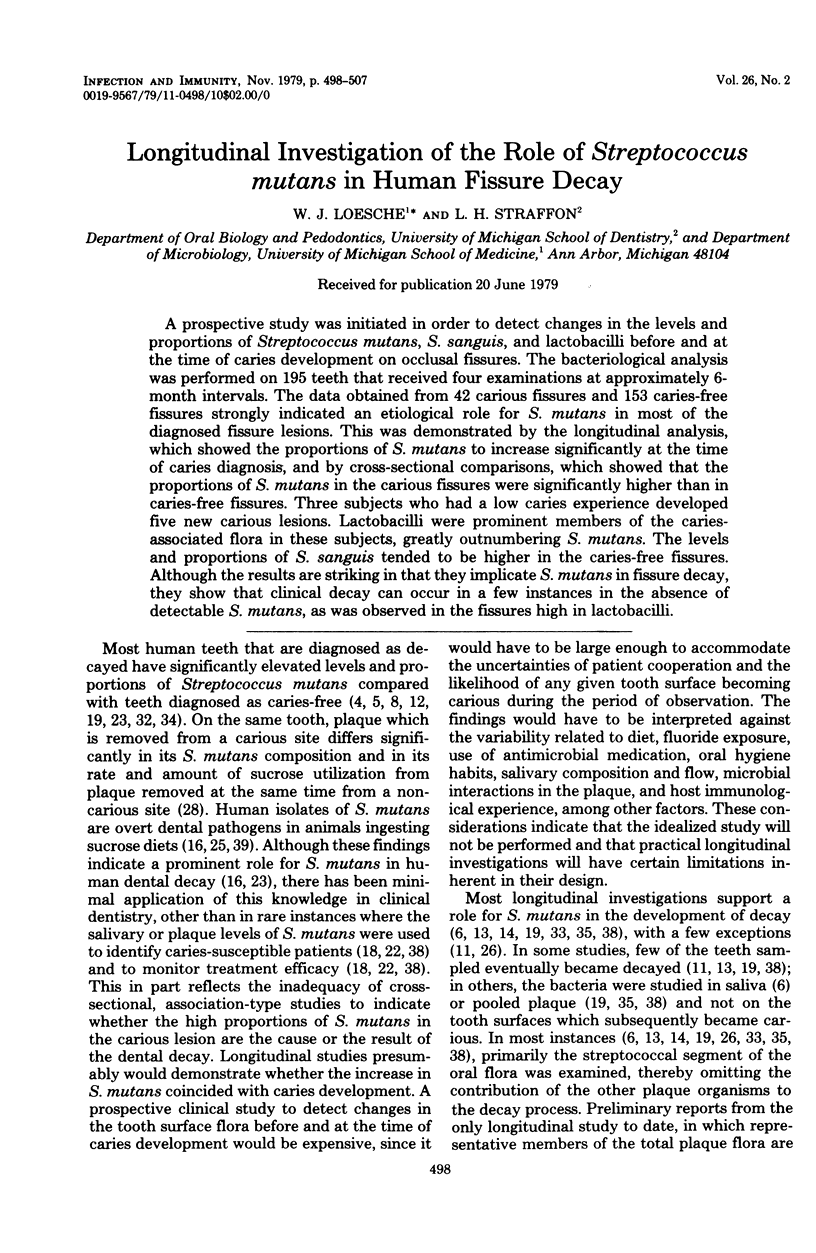
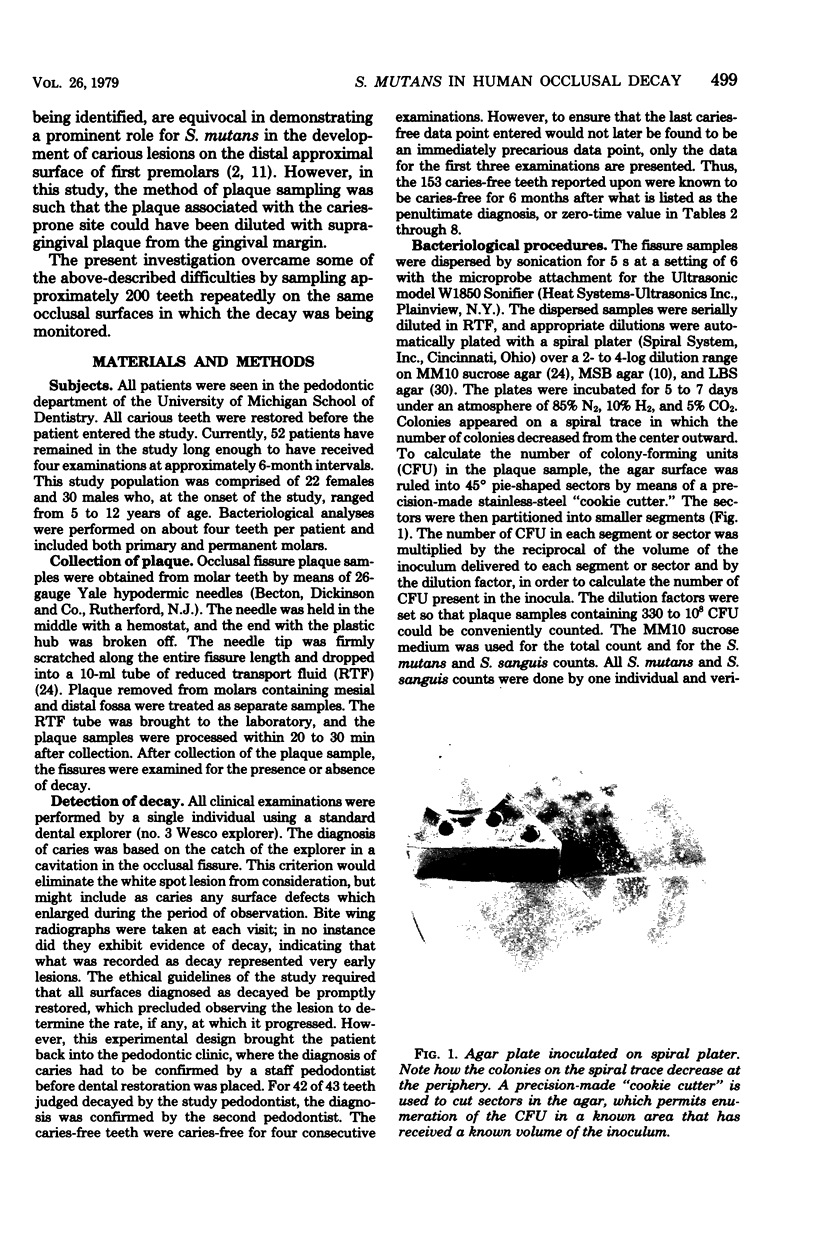
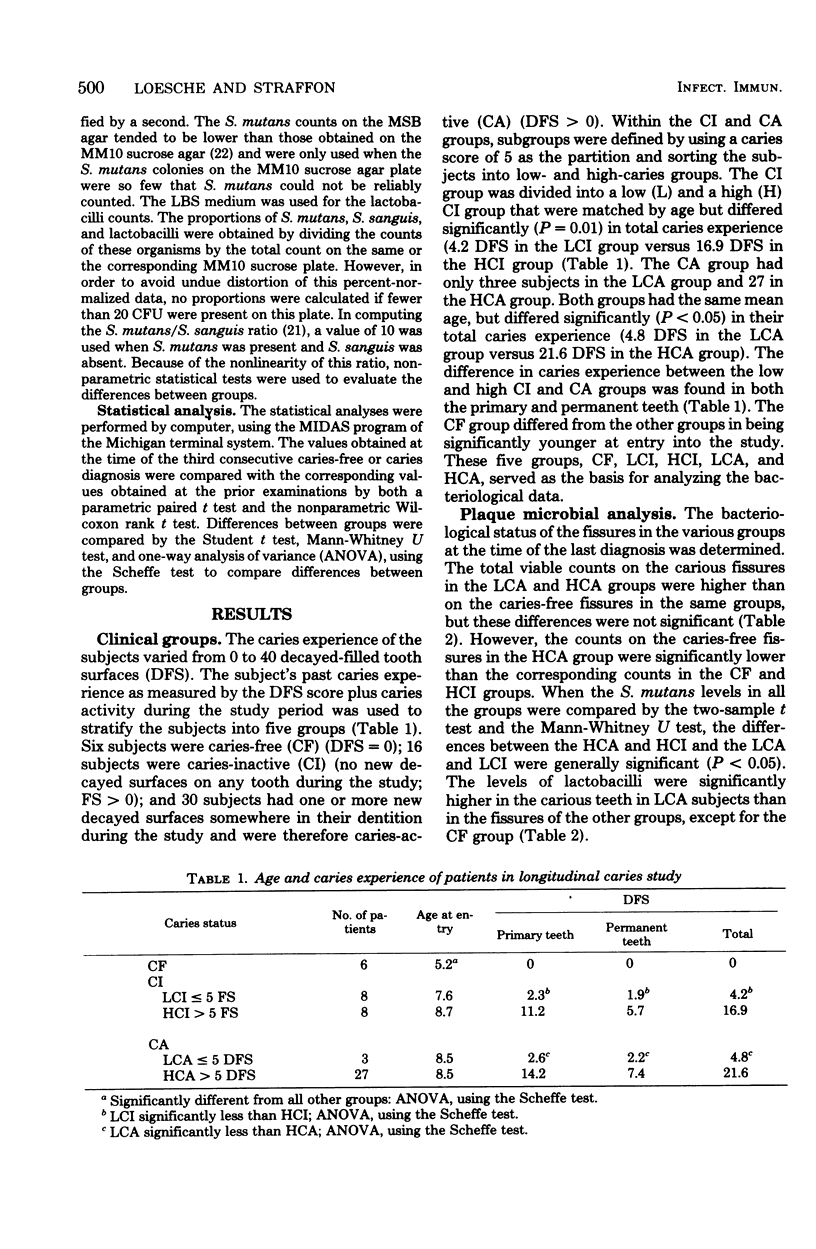
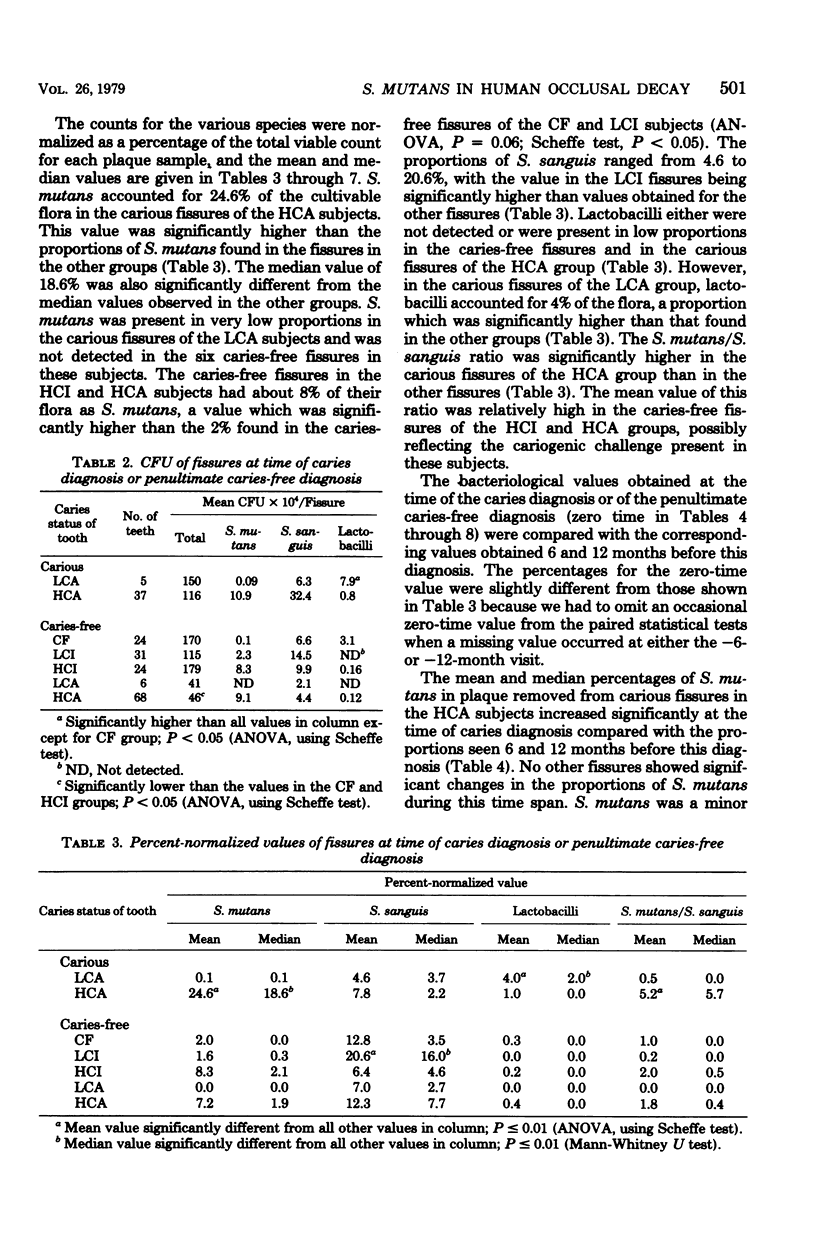
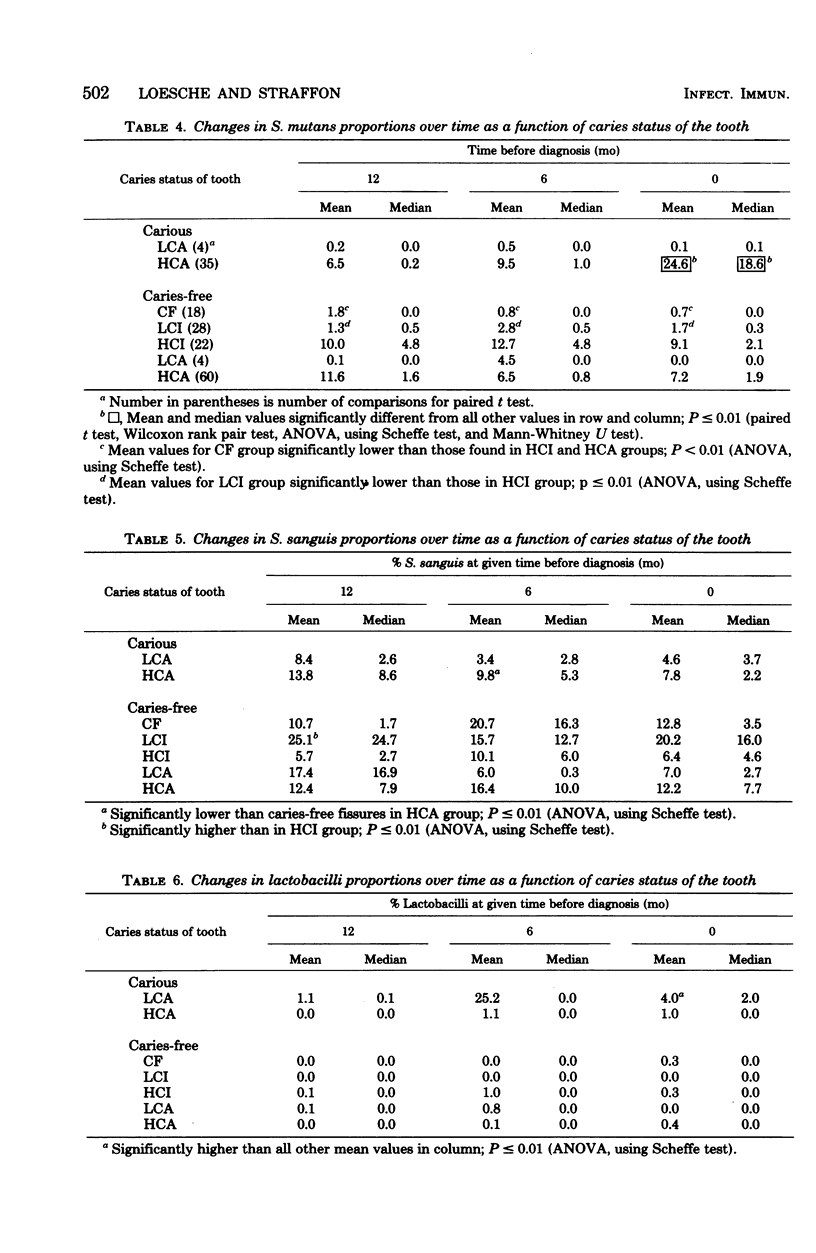
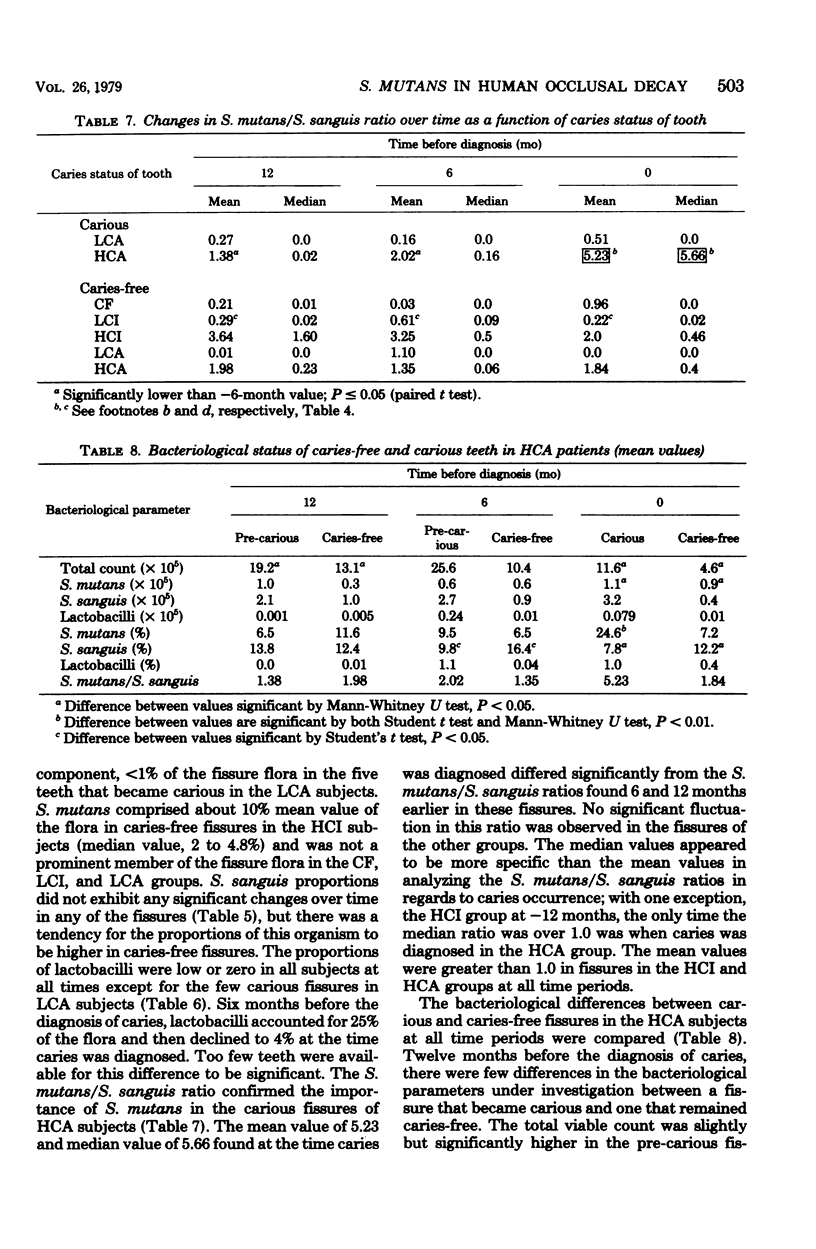
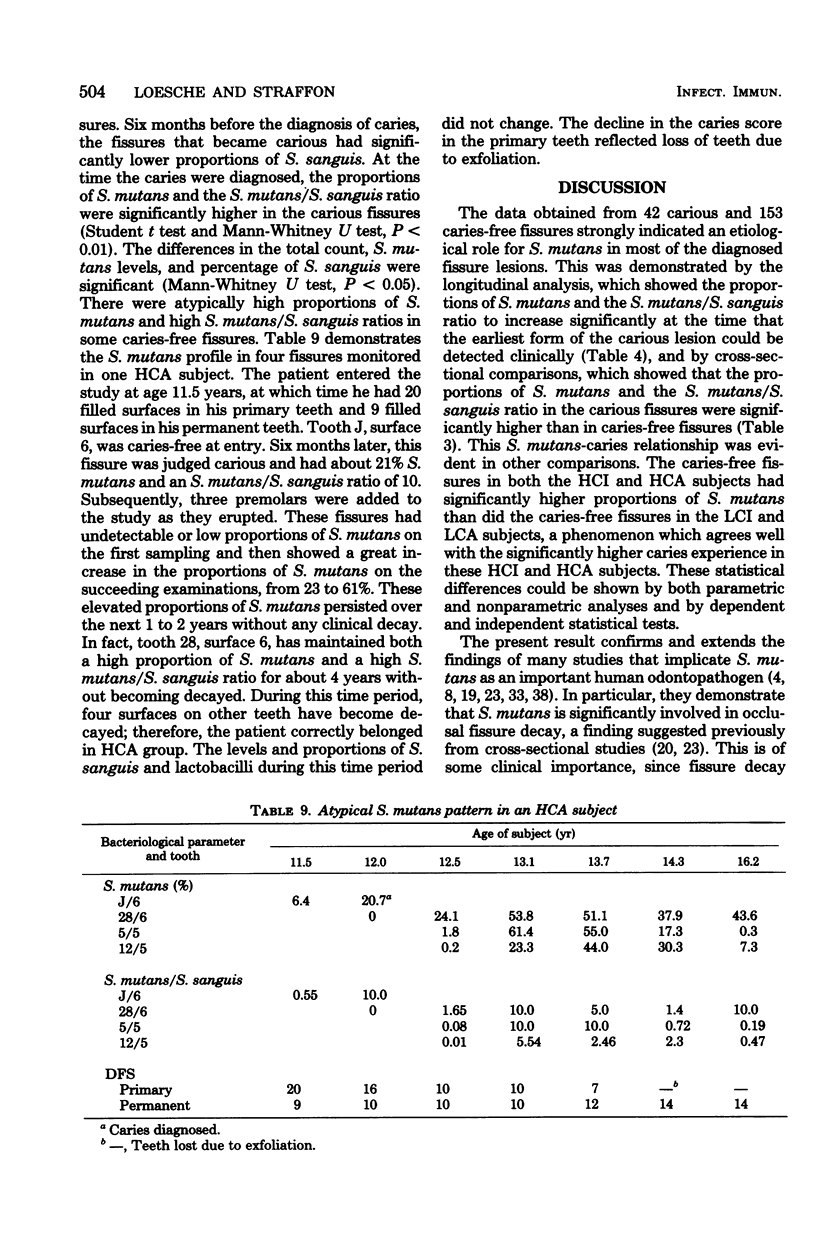
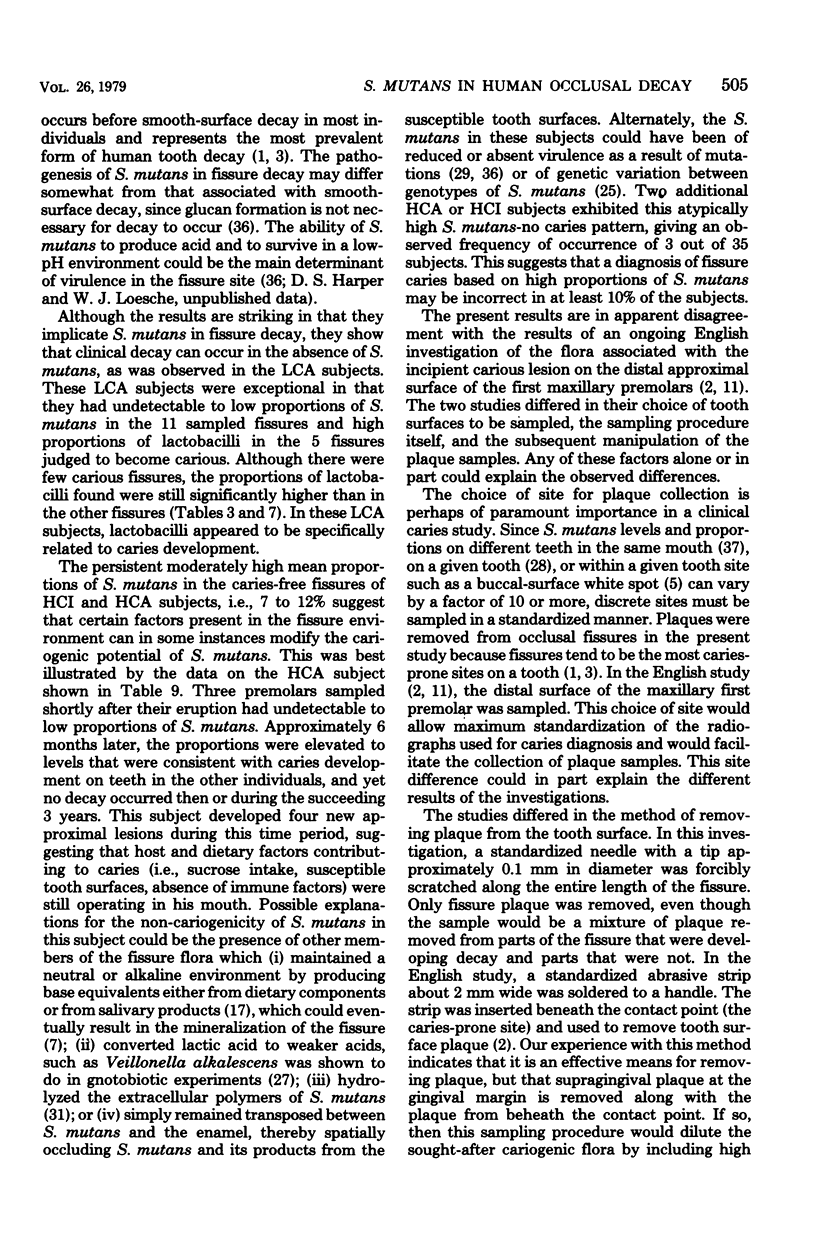
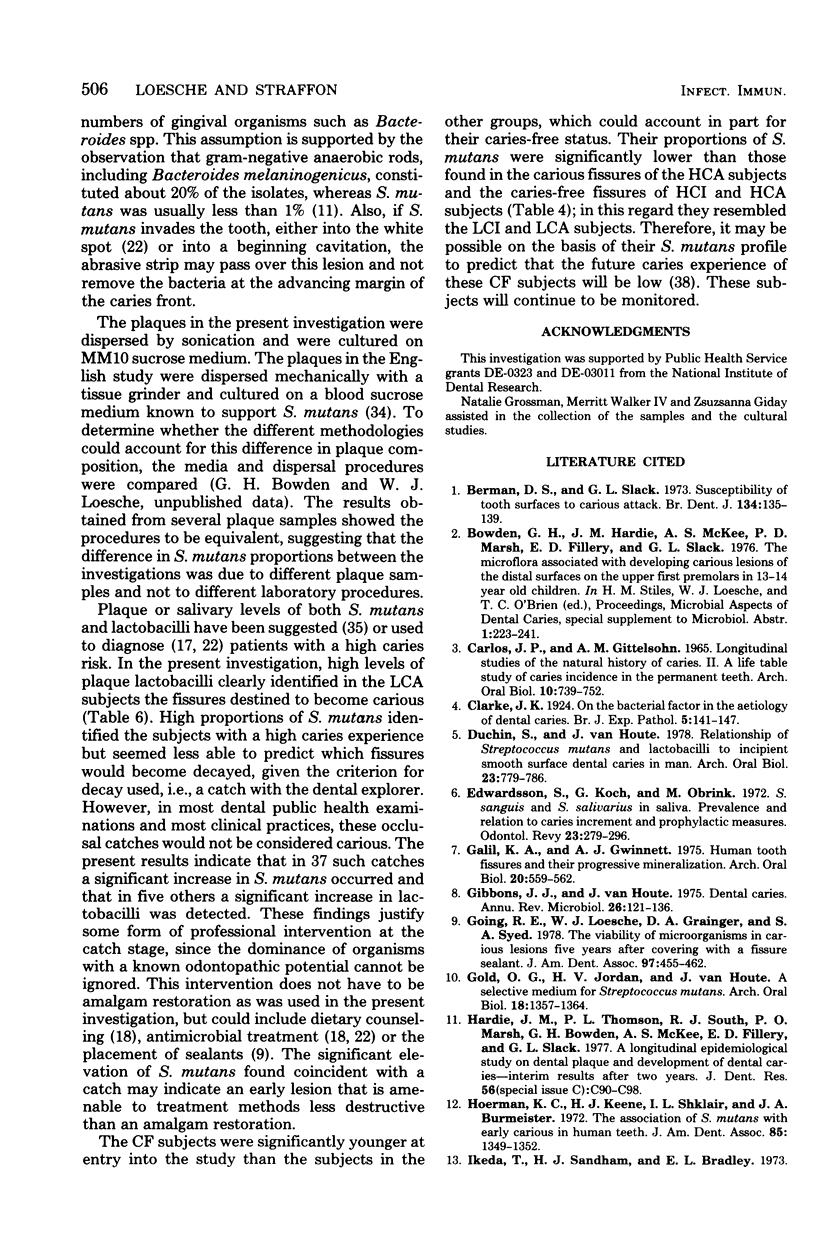
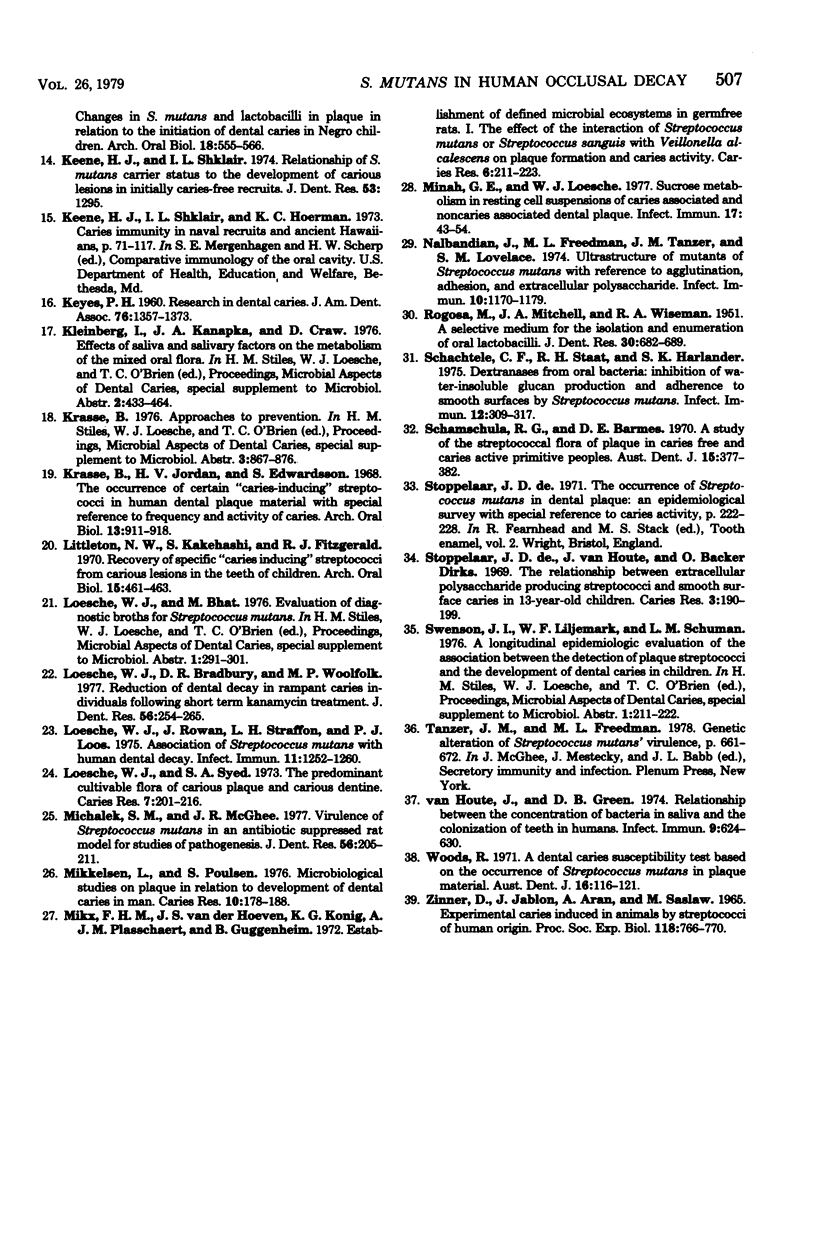
Images in this article
Selected References
These references are in PubMed. This may not be the complete list of references from this article.
- Berman D. S., Slack G. L. Susceptibility of tooth surfaces to carious attack. A longitudinal study. Br Dent J. 1973 Feb 20;134(4):135–139. doi: 10.1038/sj.bdj.4802968. [DOI] [PubMed] [Google Scholar]
- Carlos J. P., Gittelsohn A. M. Longitudinal studies of the natural history of caries. II. A life-table study of caries incidence in the permanent teeth. Arch Oral Biol. 1965 Sep-Oct;10(5):739–751. doi: 10.1016/0003-9969(65)90127-5. [DOI] [PubMed] [Google Scholar]
- De Stoppelaar J. D., Van Houte J., Backer Dirks O. The relationship between extracellular polysaccharide-producing streptococci and smooth surface caries in 13-year-old children. Caries Res. 1969;3(2):190–199. doi: 10.1159/000259582. [DOI] [PubMed] [Google Scholar]
- Duchin S., van Houte J. Relationship of Streptococcus mutans and lactobacilli to incipient smooth surface dental caries in man. Arch Oral Biol. 1978;23(9):779–786. doi: 10.1016/0003-9969(78)90155-3. [DOI] [PubMed] [Google Scholar]
- Edwardsson S., Koch G., Obrink M. Strep. sanguis, Strep. mutans and Strep. salivarius in saliva. Prevalence and relation to caries increment and prophylactic measures. Odontol Revy. 1972;23(3):279–296. [PubMed] [Google Scholar]
- Galil K. A., Gwinnett A. J. Human tooth-fissure contents and their progressive mineralization. Arch Oral Biol. 1975 Sep;20(9):559–562. doi: 10.1016/0003-9969(75)90074-6. [DOI] [PubMed] [Google Scholar]
- Gibbons R. J., van Houte J. Dental caries. Annu Rev Med. 1975;26:121–136. doi: 10.1146/annurev.me.26.020175.001005. [DOI] [PubMed] [Google Scholar]
- Going R. E., Loesche W. J., Grainger D. A., Syed S. A. The viability of microorganisms in carious lesions five years after covering with a fissure sealant. J Am Dent Assoc. 1978 Sep;97(3):455–462. doi: 10.14219/jada.archive.1978.0327. [DOI] [PubMed] [Google Scholar]
- Hardie J. M., Thomson P. L., South R. J., Marsh P. D., Bowden G. H., McKee A. S., Fillery E. D., Slack G. L. A longitudinal epidemiological study on dental plaque and the development of dental caries--interim results after two years. J Dent Res. 1977 Oct;56(Spec No):C90–C98. doi: 10.1177/00220345770560032401. [DOI] [PubMed] [Google Scholar]
- Hoerman K. C., Keene H. J., Shklair I. L., Burmeister J. A. The association of Streptococcus mutans with early carious lesions in human teeth. J Am Dent Assoc. 1972 Dec;85(6):1349–1352. doi: 10.14219/jada.archive.1972.0511. [DOI] [PubMed] [Google Scholar]
- Ikeda T., Sandham H. J., Bradley E. L., Jr Changes in Streptococcus mutans and lactobacilli in plaque in relation to the initiation of dental caries in Negro children. Arch Oral Biol. 1973 Apr;18(4):555–566. doi: 10.1016/0003-9969(73)90076-9. [DOI] [PubMed] [Google Scholar]
- Keene H. J., Shklair I. L. Relationship of Streptococcus mutans carrier status to the development of carious lesions in initially cariesfree recruits. J Dent Res. 1974 Sep-Oct;53(5):1295–1295. doi: 10.1177/00220345740530053801. [DOI] [PubMed] [Google Scholar]
- Keyes P. H. Research in dental caries. J Am Dent Assoc. 1968 Jun;76(6):1357–1373. doi: 10.14219/jada.archive.1968.0186. [DOI] [PubMed] [Google Scholar]
- Krasse B., Jordan H. V., Edwardsson S., Svensson I., Trell L. The occurrence of certain "caries-inducing" streptococci in human dental plaque material with special reference to frequency and activity of caries. Arch Oral Biol. 1968 Aug;13(8):911–918. doi: 10.1016/0003-9969(68)90006-x. [DOI] [PubMed] [Google Scholar]
- Littleton N. W., Kakehashi S., Fitzgerald R. J. Recovery of specific "caries-inducing" streptococci from carious lesions in the teeth of children. Arch Oral Biol. 1970 May;15(5):461–463. doi: 10.1016/0003-9969(70)90073-7. [DOI] [PubMed] [Google Scholar]
- Loesche W. J., Bradbury D. R., Woolfolk M. P. Reduction of dental decay in rampant caries individuals following short-term kanamycin treatment. J Dent Res. 1977 Mar;56(3):254–265. doi: 10.1177/00220345770560031101. [DOI] [PubMed] [Google Scholar]
- Loesche W. J., Rowan J., Straffon L. H., Loos P. J. Association of Streptococcus mutants with human dental decay. Infect Immun. 1975 Jun;11(6):1252–1260. doi: 10.1128/iai.11.6.1252-1260.1975. [DOI] [PMC free article] [PubMed] [Google Scholar]
- Loesche W. J., Syed S. A. The predominant cultivable flora of carious plaque and carious dentine. Caries Res. 1973;7(3):201–216. doi: 10.1159/000259844. [DOI] [PubMed] [Google Scholar]
- Michalek S. M., McGhee J. R. Virulence of Streptococcus mutans: an antibiotic-suppressed rat model for studies of pathogenesis. J Dent Res. 1977 Mar;56(3):205–211. doi: 10.1177/00220345770560030301. [DOI] [PubMed] [Google Scholar]
- Mikkelsen L., Poulsen S. Microbiological studies on plaque in relation to development of dental caries in man. Caries Res. 1976;10(3):178–188. doi: 10.1159/000260200. [DOI] [PubMed] [Google Scholar]
- Mikx F. H., van der Hoeven J. S., König K. G., Plasschaert A. J., Guggenheim B. Establishment of defined microbial ecosystems in germ-free rats. I. The effect of the interactions of streptococcus mutans or Streptococcus sanguis with Veillonella alcalescens on plaque formation and caries activity. Caries Res. 1972;6(3):211–223. doi: 10.1159/000259801. [DOI] [PubMed] [Google Scholar]
- Minah G. E., Loesche W. J. Sucrose metabolism in resting-cell suspensions of caries associated and non-caries-associated dental plaque. Infect Immun. 1977 Jul;17(1):43–54. doi: 10.1128/iai.17.1.43-54.1977. [DOI] [PMC free article] [PubMed] [Google Scholar]
- Nalbandian J., Freedman M. L., Tanzer J. M., Lovelace S. M. Ultrastructure of Mutants of Streptococcus mutans with Reference to Agglutination, Adhesion, and Extracellular Polysaccharide. Infect Immun. 1974 Nov;10(5):1170–1179. doi: 10.1128/iai.10.5.1170-1179.1974. [DOI] [PMC free article] [PubMed] [Google Scholar]
- ROGOSA M., MITCHELL J. A., WISEMAN R. F. A selective medium for the isolation and enumeration of oral lactobacilli. J Dent Res. 1951 Oct;30(5):682–689. doi: 10.1177/00220345510300051201. [DOI] [PubMed] [Google Scholar]
- Schachtele C. F., Staat R. H., Harlander S. K. Dextranases from oral bacteria: inhibition of water-insoluble glucan production and adherence to smooth surfaces by Streptococcus mutans. Infect Immun. 1975 Aug;12(2):309–317. doi: 10.1128/iai.12.2.309-317.1975. [DOI] [PMC free article] [PubMed] [Google Scholar]
- Schamschula R. G., Barmes D. E. A study of the streptococcal flora of plaque in caries free and caries active primitive peoples. Aust Dent J. 1970 Oct;15(5):377–382. doi: 10.1111/j.1834-7819.1970.tb01693.x. [DOI] [PubMed] [Google Scholar]
- Tanzer J. M., Freedman M. L. Genetic alterations of Streptococcus mutans' virulence. Adv Exp Med Biol. 1978;107:661–672. doi: 10.1007/978-1-4684-3369-2_75. [DOI] [PubMed] [Google Scholar]
- Van Houte J., Green D. B. Relationship between the concentration of bacteria in saliva and the colonization of teeth in humans. Infect Immun. 1974 Apr;9(4):624–630. doi: 10.1128/iai.9.4.624-630.1974. [DOI] [PMC free article] [PubMed] [Google Scholar]
- Woods R. A dental caries susceptibility test based on the occurrence of Streptococcus mutans in plaque material. Aust Dent J. 1971 Apr;16(2):116–121. doi: 10.1111/j.1834-7819.1971.tb02314.x. [DOI] [PubMed] [Google Scholar]
- ZINNER D. D., JABLON J. M., ARAN A. P., SASLAW M. S. EXPERIMENTAL CARIES INDUCED IN ANIMALS BY STREPTOCOCCI OF HUMAN ORIGIN. Proc Soc Exp Biol Med. 1965 Mar;118:766–770. doi: 10.3181/00379727-118-29964. [DOI] [PubMed] [Google Scholar]



